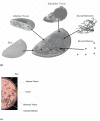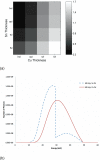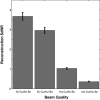Dual-energy contrast-enhanced breast tomosynthesis: optimization of beam quality for dose and image quality
- PMID: 21908902
- PMCID: PMC4147785
- DOI: 10.1088/0031-9155/56/19/013
Dual-energy contrast-enhanced breast tomosynthesis: optimization of beam quality for dose and image quality
Abstract
Dual-energy contrast-enhanced breast tomosynthesis is a promising technique to obtain three-dimensional functional information from the breast with high resolution and speed. To optimize this new method, this study searched for the beam quality that maximized image quality in terms of mass detection performance. A digital tomosynthesis system was modeled using a fast ray-tracing algorithm, which created simulated projection images by tracking photons through a voxelized anatomical breast phantom containing iodinated lesions. The single-energy images were combined into dual-energy images through a weighted log subtraction process. The weighting factor was optimized to minimize anatomical noise, while the dose distribution was chosen to minimize quantum noise. The dual-energy images were analyzed for the signal difference to noise ratio (SdNR) of iodinated masses. The fast ray-tracing explored 523 776 dual-energy combinations to identify which yields optimum mass SdNR. The ray-tracing results were verified using a Monte Carlo model for a breast tomosynthesis system with a selenium-based flat-panel detector. The projection images from our voxelized breast phantom were obtained at a constant total glandular dose. The projections were combined using weighted log subtraction and reconstructed using commercial reconstruction software. The lesion SdNR was measured in the central reconstructed slice. The SdNR performance varied markedly across the kVp and filtration space. Ray-tracing results indicated that the mass SdNR was maximized with a high-energy tungsten beam at 49 kVp with 92.5 µm of copper filtration and a low-energy tungsten beam at 49 kVp with 95 µm of tin filtration. This result was consistent with Monte Carlo findings. This mammographic technique led to a mass SdNR of 0.92 ± 0.03 in the projections and 3.68 ± 0.19 in the reconstructed slices. These values were markedly higher than those for non-optimized techniques. Our findings indicate that dual-energy breast tomosynthesis can be performed optimally at 49 kVp with alternative copper and tin filters, with reconstruction following weighted subtraction. The optimum technique provides best visibility of iodine against structured breast background in dual-energy contrast-enhanced breast tomosynthesis.
Figures













Similar articles
-
Optimization of a dual-energy contrast-enhanced technique for a photon-counting digital breast tomosynthesis system: I. A theoretical model.Med Phys. 2010 Nov;37(11):5896-907. doi: 10.1118/1.3490556. Med Phys. 2010. PMID: 21158302 Free PMC article.
-
Optimization of a dual-energy contrast-enhanced technique for a photon-counting digital breast tomosynthesis system: II. An experimental validation.Med Phys. 2010 Nov;37(11):5908-13. doi: 10.1118/1.3488889. Med Phys. 2010. PMID: 21158303 Free PMC article.
-
Effects on image quality of a 2D antiscatter grid in x-ray digital breast tomosynthesis: Initial experience using the dual modality (x-ray and molecular) breast tomosynthesis scanner.Med Phys. 2016 Apr;43(4):1720. doi: 10.1118/1.4943632. Med Phys. 2016. PMID: 27036570 Free PMC article.
-
Optimization of contrast-enhanced breast imaging: Analysis using a cascaded linear system model.Med Phys. 2017 Jan;44(1):43-56. doi: 10.1002/mp.12004. Epub 2017 Jan 3. Med Phys. 2017. PMID: 28044312
-
Performance evaluation of digital breast tomosynthesis systems: comparison of current virtual clinical trial methods.Phys Med Biol. 2022 Nov 16;67(22). doi: 10.1088/1361-6560/ac9a34. Phys Med Biol. 2022. PMID: 36228626 Review.
Cited by
-
A review of breast tomosynthesis. Part II. Image reconstruction, processing and analysis, and advanced applications.Med Phys. 2013 Jan;40(1):014302. doi: 10.1118/1.4770281. Med Phys. 2013. PMID: 23298127 Free PMC article. Review.
-
Investigation of x-ray spectra for iodinated contrast-enhanced dedicated breast CT.J Med Imaging (Bellingham). 2017 Jan;4(1):013504. doi: 10.1117/1.JMI.4.1.013504. Epub 2017 Jan 26. J Med Imaging (Bellingham). 2017. PMID: 28149923 Free PMC article.
-
Dual Energy Method for Breast Imaging: A Simulation Study.Comput Math Methods Med. 2015;2015:574238. doi: 10.1155/2015/574238. Epub 2015 Jul 13. Comput Math Methods Med. 2015. PMID: 26246848 Free PMC article.
-
Combined Benefit of Quantitative Three-Compartment Breast Image Analysis and Mammography Radiomics in the Classification of Breast Masses in a Clinical Data Set.Radiology. 2019 Mar;290(3):621-628. doi: 10.1148/radiol.2018180608. Epub 2018 Dec 11. Radiology. 2019. PMID: 30526359 Free PMC article.
-
Dual-energy CT imaging with limited-angular-range data.Phys Med Biol. 2021 Sep 17;66(18):10.1088/1361-6560/ac1876. doi: 10.1088/1361-6560/ac1876. Phys Med Biol. 2021. PMID: 34320478 Free PMC article.
References
-
- Robson M, Offit K. Management of an Inherited Predisposition to Breast Cancer. N. Engl. J. Med. 2007;357:154–162. - PubMed
-
- National Comprehensive Cancer Network [July 25, 2007];Clinical practice guidelines in oncology: genetic/familial high-risk assessment: breast and ovarian. 2007 Version 1.2007 Available at: http://www.nccn.org/professionals/physician_gls/PDF/genetics_screening.pdf.
-
- National Institute for Health and Clinical Excellence [July 25, 2007];Familial breast cancer: the classification and care of women at risk of familial breast cancer in primary, secondary and tertiary care. CG 41. 2006 Available at: http://www.nice.org.uk/guidance/cg41.
-
- Saslow D, Boetes C, Burke W, Harms S, Leach MO, Lehman CD, Morris E, Pisano E, Schnall M, Sener S, Smith RA, Warner E, Yaffe M, Andrews KS, Russell CA, G., for the American Cancer Society Breast Cancer Advisory American Cancer Society Guidelines for Breast Screening with MRI as an Adjunct to Mammography. CA. Cancer J. Clin. 2007;57:75–89. - PubMed
-
- Buist DSM, Porter PL, Lehman C, Taplin SH, White E. Factors Contributing to Mammography Failure in Women Aged 40-49 Years. J. Natl. Cancer Inst. 2004;96:1432–1440. - PubMed
Publication types
MeSH terms
Substances
Grants and funding
LinkOut - more resources
Full Text Sources
Medical
